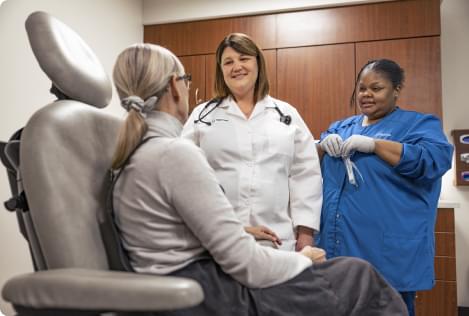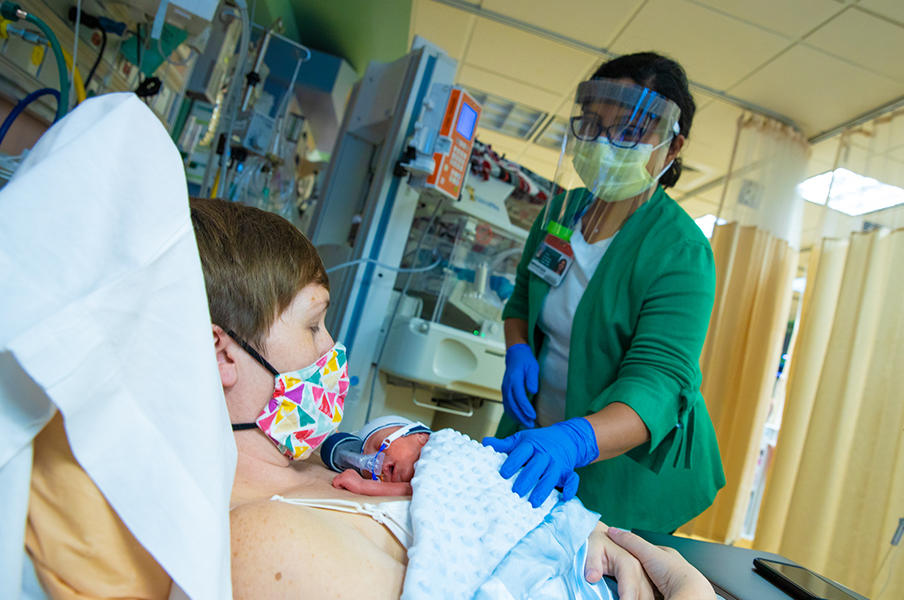RNICU Terms:
ABG/Arterial Blood Gas/Blood Gas
A test performed on blood taken from an artery to determine the levels of oxygen and carbon dioxide. This is one way to determine how well a baby is breathing.
Anemia
A decrease in red blood cells which carry oxygen to all tissues of the body. In severe anemia or very sick infants, transfusion of blood may be required.
Antibiotics
Drugs that kill bacteria. They are given to treat infections caused by bacteria but not those caused by viruses.
Apnea
A pause in breathing often followed by a decrease in heart rate, oxygen saturation, or change in color. Premature babies often experience apnea due to immature breathing centers in their brains.
Bilirubin
A substance released when the body breaks down red blood cells. Too much bilirubin causes jaundice.
Bradycardia
A slowing of the heart rate, generally to less than 80 beats per minute for a newborn baby.
Continuous Feeding
Breast milk or formula given through a feeding tube into the infant's stomach, at a constant rate.
CPAP
Continuous positive airway pressure. Air, with or without extra oxygen, given to the infant through small soft tubes in the nose. The pressure keeps the air sacs in the lungs open, making it easier for the baby to breathe.
Culture
A laboratory test on blood or other body fluid to check for the presence of infection.
Desats or Desaturation
A decrease in the amount of oxygen in a baby's red blood cells.
Electrolytes or Lytes
Chemicals in the blood that are needed for proper body function. These include sodium (Na), potassium (K), chloride (CI), calcium (Ca), and magnesium (Mg).
ET Tube or Endotracheal Tube
A tube placed through a baby's windpipe (trachea) into their lungs and connected to a ventilator (respirator).
Gavage Feeding or Tube Feeding
Breast milk or formula given through a feeding tube. The feeding tube goes through the baby's nose or mouth into the stomach.
Gestational Age
The number of weeks that have passed between the first day of the last menstrual period and the date of birth. Term pregnancy is 40 weeks gestation.
Isolette or Incubator
A heated, clear plastic box-like enclosure in which premature or sick babies are placed.
IVH or Intraventricular Hemorrhage
Bleeding within the brain cavities (ventricles). The doctor will order a cranial ultrasound to check for IVH in small premature infants at risk. Your doctor will discuss the findings with you.
Jaundice
Yellow skin color that occurs from the buildup of bilirubin.
NEC
Necrotizing enterocolitis is a severe inflammation of the bowel that may require surgery. When this condition is suspected, babies will be started on antibiotics, IV fluids and will have bowel rest (no enteral feeding) until the bowel recovers.
NPO
Baby is given only intravenous fluids with no oral feedings.
Oscillator
High-frequency oscillatory ventilation is a breathing machine that does not give a true "breath" but vibrates air and oxygen in a baby's lungs.
Oxygen Saturation
A monitored valve that shows the percentage of oxygen in a baby's blood.
Oxyhood
A clear plastic box placed over a baby's head so that extra oxygen can be given.
PDA
Patent ductus arteriosus. The ductus arteriosus is a short blood vessel near the baby's heart that connects the lung artery with the aorta (a blood vessel that carries blood to the body). Before birth, it carries blood away from the baby's lungs directly to the body. This vessel should close shortly after birth. If it does not, it is called a patent ductus arteriosus and may need medical treatment.
PERC Line or PICC Line
A thin tube inserted and threaded into a vein, usually in the arm or leg. This is one type of IV site used to give fluids and medications to a baby.
Phototherapy
A bright light shined on a baby to treat jaundice.
RDS
Respiratory distress syndrome, sometimes called hyaline membrane disease. A condition caused by a lack of surfactant in the baby's lungs, making it difficult to breathe.
ROP
Retinopathy of prematurity is a problem of overgrowth of vessels in the retina (inside of the eyes) in very small premature infants that may lead to vision loss or blindness. The ophthalmologist will periodically check the eyes of premature infants at risk. Some babies may require laser treatment.
Residual
Breast milk or formula left in a baby's stomach, often measured before a feeding to check if it is being digested.
Sepsis
An infection in the blood that affects the whole body.
Surfactant
A soap-like substance made in the lungs that keeps the lung air sacs open. Premature babies do not have enough surfactant. It is often given to babies after birth to treat breathing problems.
TPN/IL
Total parenteral nutrition/intralipids. IV solutions that together provide total nutritional needs to the baby.
UAC/UVC
Umbilical arterial catheter/umbilical vein catheter is a thin tube inserted into a baby's umbilical cord artery or vein in order to give fluids and medications. Blood for laboratory tests can also be taken from these lines.
Vent or Ventilator
A machine that breathes for a baby. Sometimes called a respirator.
Vital signs
A baby's heart rate, breathing rate, oxygen saturation, blood pressure and temperature.



